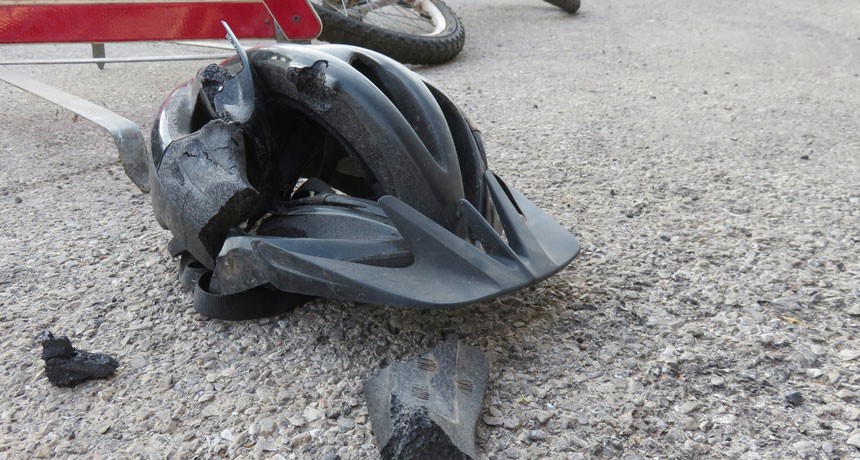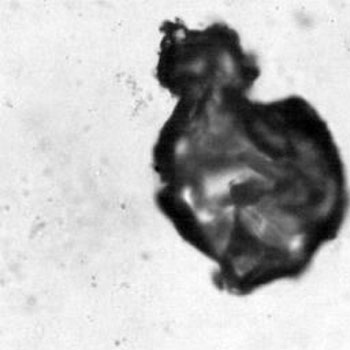Bubbles may underlie trauma’s brain injury
Explosions and especially strong jolts to the head may create bubbles that lead to “thunder in the brain”

Helmets are meant to protect the head from injury (such as in this bicycle accident). But if the accident is serious enough, even a helmet may not prevent a TBI.
tzahiV/ iStockphoto
By Sid Perkins
When soldiers are caught in an explosion, the blast releases intense vibrations. These pressure waves bombard — and damage — tissues throughout their bodies. Most of those tissues will heal with time. But effects on the brain can be severe and long lasting. That damage is called traumatic brain injury, or TBI for short. Scientists still aren’t exactly sure what goes on inside the brain to create TBI. But if they could figure it out, they might be able to help prevent it. One research team suspects those pressure waves create bubbles in the brain. And their new data show that if they do, such bubbles could cause the types of damage that could lead to TBI.
Christian Franck works at Brown University in Providence, R.I. He presented his team’s findings on November 23 in Boston, Mass., at the annual meeting there of the American Physical Society’s division of fluid dynamics.
Sound waves and sonic booms are examples of pressure waves. As an aerospace engineer, Franck has spent a lot of time studying how pressure waves behave in air, solids and fluids. But he’s also studied how concussions affect brain cells. Concussions often result from impacts to the head, such as might occur in auto accidents or collisions between players in football.
Those collisions can kill nerve cells. Now, Franck and his team wanted to look at what might happen when nerve cells — also called neurons — are bombarded by even more intense pressure waves.
They had grown these cells in a mix of proteins such as collagen. (Collagen is the main protein that gives structure to tissues such as bones, cartilage and tendons.) In this mixture, neurons grow and form connections just as they do in a real brain. But they aren’t packed together as tightly as are neurons in the brain. That’s a plus because it makes it easier to study damage to individual cells, Franck says.

The laser vaporized tissue wherever its beam was focused. This is similar to what happens when lightning passes through the air. Lightning briefly heats air to about 28,000° Celsius (50,000° Fahrenheit). That’s approximately five times as hot as the surface of the sun. After the bolt has passed, the air quickly cools down. When the surrounding air rushes in to fill the low pressure zone, it slams together and creates thunder.
In his new experiments, the laser instantly created a bubble of steam, which collapsed as soon as the laser turned off. The steam bubble’s fast expansion and sudden collapse caused the cell damage he sought to study.
Lasers aren’t going off in the brains of people caught in explosions, of course. Indeed, they don’t even produce their bubbles by pressure waves. But Franck believes these bubbles should resemble any produced in the brain by pressure waves. Why? Waves of high pressure would reflect off of structures inside the brain, such as blood vessels and the boundaries between tissues. Then, those echoes would create zones of low pressure. It’s there that bubbles would form, he suspects. When bubbles form inside a fluid, it’s called cavitation. When the bubbles are tiny, it’s called microcavitation.
BURSTING BUBBLES A laser pulse vaporizes tissue and creates a bubble, which quickly collapses. This process, called cavitation, may be happening inside the brains of people exposed to intense explosions. Christian Franck, funded by the Office of Naval Research |
Cavitation often occurs on the backs of boat propellers. That’s because pressure at that location becomes low enough for bubbles of water vapor to form. Over time, the repeated creation and collapse of these bubbles can actually wear away steel. So imagine what even a single encounter might do to delicate brain tissue, Franck says.
“Researchers don’t know if cavitation in the brain is causing TBI. But if it does occur, it could cause serious damage,” says Eric Johnsen. He studies fluid mechanics — how liquids and gases react under pressure — at the University of Michigan in Ann Arbor. Franck’s research is important, Johnsen says, “because we need to understand what cavitation might do to brain tissue.”
Franck says one of his goals is to see if cavitation leaves a distinct type of damage in the brain. If it does, researchers should be able to diagnose TBI by looking for this telltale signature. They could either use a small sample taken while the patient is alive, or analyze the tissue after death, during an autopsy.
Another goal of the team’s work is to find out if microcavitation kills brain cells the same way a concussion does. It’s possible that a TBI is essentially a concussion on steroids. It may simply kill more cells at one time than a typical concussion does. In earlier tests that simulated concussions, neurons swelled in certain spots whenever they were stretched, compressed or twisted very quickly. Then, the cells let go of their neighbors, and within hours died.
If bubbles are behind TBIs, as Franck now suspects, then figuring out how to prevent or minimize pressure waves inside the skull might help more than soldiers. He notes that officers on SWAT teams who use explosives to knock down doors — as well as the people who train them — may also be at risk for TBIs.
And explosions might not be the only source of TBIs. Some studies suggest that many small jolts might have the same overall effect on brain tissue as one big blast. That means Franck’s findings also could prove useful for both kids and adults who play sports that involve repeated hits to the head, such as soccer, football and boxing.
Power Words
(for more about Power Words, click here)
aerospace A research field devoted to the study of Earth’s atmosphere and the space beyond or to aircraft that travel in the atmosphere and space.
cavitation The formation and quick collapse of bubbles in a liquid, caused by mechanical force.
concussion Temporary unconsciousness, or headache, dizziness or forgetfulness due to a severe blow to the head.
engineer A person who uses science to solve problems. As a verb, to engineer means to design a device, material or process that will solve some problem or unmet need.
fluid mechanics The study of the properties of fluids (liquids and gases) and their reactions to the forces acting upon them under various conditions.
laser A device that generates an intense beam of coherent light of a single color. Lasers are used in drilling and cutting, alignment and guidance, in data storage and in surgery.
neuron A cell that serves as the basic working unit of the nervous system. It carries electrical signals from and between nerves.
pressure Force applied uniformly over a surface, measured as force per unit of area.
SWAT An acronym that stands for Special Weapons and Tactics. Military and police departments often have special SWAT troops trained to work with hazardous materials or especially dangerous weaponry.
traumatic brain injury Damage to the brain that results from an external shock, such as an explosion, or a direct impact (as can occur in a car accident). Also called TBI, the damage can lead to either temporary or permanent impairment of thinking, memory and movements of the body.







